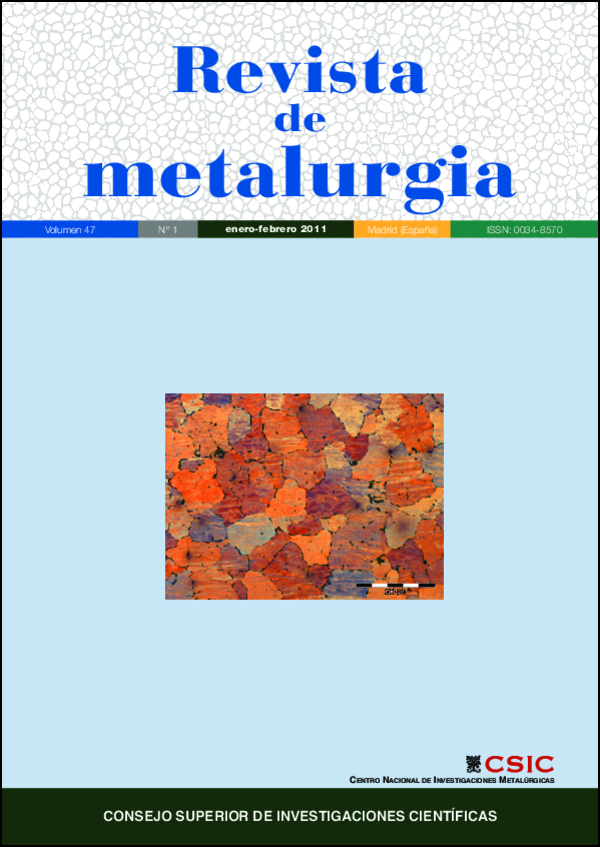Characterization of dual-phase steels obtained by hot-rolling
DOI:
https://doi.org/10.3989/revmetalmadrid.0914Keywords:
Steels, Dual-Phase, Hot-rolling, Textures, DrawingAbstract
Samples were obtained from C-Mn-Si steel available in the market. Through a hot rolling and coiling process, it was possible to obtain Dual-Phase steel with microstructural and mechanical properties in the theoretical range typical of this material. The thermomechanical process consisted of a strong reduction by multiples pass of hot rolling at temperatures above Ar3, controlled-cooling the sheets during 5 s (at a rate of 20 °C/s in the equilibrium range α+γ. Temperature Ar3 measured by differential scanning calorimetry was 890 °C. Quenching was then carried out in the coiling temperatures range (500-675 °C), cooling the samples in accordance to an established curve that corresponds to the actual cooling curve of a coil. The microstructural characterization of the samples obtained was carried out by optical microscopy, scanning electron microscopy and atomic force microscopy. Additionally, texture measurements were carried out by X-ray diffraction in order to study the resulting orientations due to the finishing rolling temperature and coiling temperature, determining the influence on these parameters of the different texture components. The microstructural results were complemented with the normal and planar anisotropy indexes measured in according to the ASTM E-517 standard. The intensities of the different texture components were correlated with the values of anisotropy indexes, finding that it is possible to obtain only a slightly enhancement in the normal anisotropy index through an appropriate combination of finish rolling and coiling temperatures.
Downloads
References
[1] B. Gardey, S. Bouvier, V. Richard y B. Bacroix, Mater. Sci. and Eng. A 400-401 (2005) 136-141. doi:10.1016/j.msea.2005.01.066
[2] A. Kumar, S. B. Singh y K.K. Ray, Mater. Sci. and Eng. A 474 (2008) 270-282. doi:10.1016/j.msea.2007.05.007
[3] R. Petrov, L. Kestens, A. Wasilkowska e Y. Houbaert, Mater. Sci. Eng. A 447 (2007) 285-297. doi:10.1016/j.msea.2006.10.023
[4] R. K. Ray y J.J. Jonas, Inter. Mater. Rev. 35 (1990) 1-36.
[5] R. K. Ray, J.J. Jonas y R.R. Hook, Inter. Mater. Rev. 39 (1994) 129-172.
[6] A. Monsalve, A. Artigas, D. Celentano y F.Meléndez, Rev.Metal.Madrid (2004) 193-198.
[7] F. S. LePera, J.l of Met. 32 (1980) 38-39.
[8] T. Waterschoot, L. Kestens y B.C. De Cooman, Mat. Met. Trans. A 33 (2002) 1.091-1.102.
[9] C. A. Charles, Mat. Sc. and Tech. 14 (1998) 496-503.
[10] A. Sakir, ISIJ International 31 (1991) 1.445-1.446.
[11] Y. Tomita, Mat. Sc. and Tech 11 (1995) 994-997.
[12] V. B. Ginzburg y R. Ballas, “Flat rolling fundamentals”, 1ª Ed. Marcel Dekker, New York, EE.UU. 2000.
[13] J. Savoie, R.K. Ray, M. P. Butrón-Guillén y J.J. Jonas, Acta Metall. Mater. 42 (1994) 2.511-2.523.
[14] S. Sun y M. Pugh, Mater. Sci. Eng. A 335 (2002) 298-308. doi:10.1016/S0921-5093(01)01942-6
[15] T. Ros-Yáñez e Y. Houbaert, A. Mertens, Mater. Charac. 47 (2001) 93-104. doi:10.1016/S1044-5803(01)00157-7
[16] A. García-Junceda, F.G. Caballero, C. Capdevila y C. García De Andrés, Scrip. Mater. 57 (2007) 89-92. doi:10.1016/j.scriptamat.2007.03.037
Downloads
Published
How to Cite
Issue
Section
License
Copyright (c) 2011 Consejo Superior de Investigaciones Científicas (CSIC)

This work is licensed under a Creative Commons Attribution 4.0 International License.
© CSIC. Manuscripts published in both the printed and online versions of this Journal are the property of Consejo Superior de Investigaciones Científicas, and quoting this source is a requirement for any partial or full reproduction.
All contents of this electronic edition, except where otherwise noted, are distributed under a “Creative Commons Attribution 4.0 International” (CC BY 4.0) License. You may read the basic information and the legal text of the license. The indication of the CC BY 4.0 License must be expressly stated in this way when necessary.
Self-archiving in repositories, personal webpages or similar, of any version other than the published by the Editor, is not allowed.
















